July’s Fungi Focus: Death Caps, False Death Caps and other amanitas
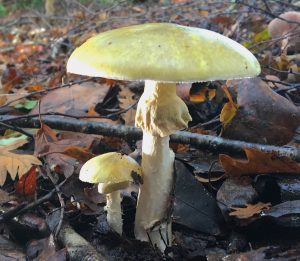
We are just easing into that time of year when the mushroom hunting season looks about set to kick off in earnest. No longer is the more fervent fungi fanatic forced into gazing obsessively into the undergrowth in search of tiny black dots on dried stalks and twigs and left to wonder which of literally thousands of potential candidates they might have found - you’ll have to wait until next year for that post, I’m afraid. No, now is the time when we can prepare to lay aside the camera’s macro lens and focus on the more readily identifiable and photogenic cap-and-stem-and-gills varieties we know as agarics.
May and June this year have been a bumper season for big brackets like Dryad’s Saddles and Chicken of the Woods all across the country, by all accounts. Though it might not seem it, it is actually a relatively short seasonal hop from late-Spring to early Autumn, when things really take off, once the weather begins to feel a bit more humid. During July we might already expect to see an advance guard of mushrooms appearing in the wetter parts of the country. Inkcaps and Marasmius species like the Fairy Ring Champignon could well be surfacing now or sometime very soon, weather permitting.
Other early fruiters less reliant on heavy rains are the various mycorrhizal varieties that form symbiotic relationships with trees, their mycelium growing around the roots and downwards into the deeper parts of the ground, accessing whatever moisture and nutrients they can’t get from the soil itself with the help of their tree host partners: the boletes, the colourful brittlegills (or russulas and the amanitas ).
The arrival of these more conventional-looking types inevitably raises issues of edibility. Just like the perennial question that crops up on various online forums for identifying plants, “Is this a flower or a weed?”, similar requests for mushrooms always seem to be qualified with the question “Can I eat it?” Just as the adage “A weed is just a plant in the wrong place” provides a good general rebuttal in a botanical or horticultural context, so too we have a mycological equivalent: “All Fungi are edible. Some fungi are only edible once.”
It doesn’t seem so long ago that people would have been very circumspect indeed about putting anything that they hadn’t bought or grown themselves into their mouths, before the likes of Ray Mears, Hugh Fearnley Whittingstall and Bear Grylls brought the idea of foraging to a mass audience freshly aware of their disconnection from the natural world and their hunter gatherer roots. If I seem slightly disparaging about the new fad for food for free with regards to mushroom gastronomy, it is because we should always remember the distinct dangers to getting this sort of thing wrong. One can imagine the best-selling author Nicholas Evans might have announced “Trust me, I’m the Horse Whisperer!” some 12 years ago when he served up a dish of the Cortinarius rubellus that he’d picked on a woodland wander, hospitalising his wife and the brother-in-law he was visiting in Scotland and winding up on a dialysis machine himself. A quick look at an identification guide would have revealed at least one fundamental difference between the ‘ceps’ he thought he’d found and the Deadly Webcaps that he and his family actually consumed, which is that the latter are gilled and the former have pores on their undersides.
It would be unfair to single out Evans for his unfortunate oversight, because there have been others who have not lived to make the same slip twice, some of whom you would have thought would have known better. It was the German mycologist Julius Schäffer who first alerted the world in 1944 to the toxicity of the Brown Rollrim (Paxillus involutus), a mushroom that had traditionally been believed to be edible.
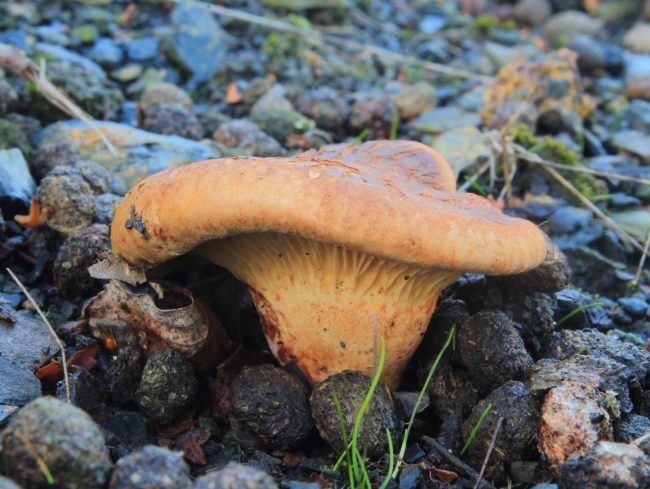
The Brown Rollrim, once believed edible, certainly not any more.
It turns out that its toxic effects were cumulative – that is, the more you eat and the longer the period of time over which they are consumed, the more likely you are to suffer adversely from their effects, like a game of Russian Roulette. Schäffer might well have eaten a lot of Brown Rollrims over his life, but in the end, it was a Brown Rollrim that saw the end of Schäffer’s life and mycological career. Mushroom guides have consequently been updated with regards to the edibility of this particular species.
The problem is exacerbated in the hive-knowledge era of social media. Every time someone posts a picture on a foraging forum or specialist Facebook group about their finds, there seems to be no shortage of would-be experts weighing in with often incorrect identifications and assessments of culinary suitability. Would you eat something that may possibly be fatal because a stranger on the internet told you it was ok? Newspaper articles drawing attention to the deadliest of the deadly types, such as this piece in the Telegraph from last year, also have a disturbing tendency to mislabel the actual mushrooms depicted in their accompanying photos.
Expertise is indeed in incredibly short supply in general when we talk about fungi, and hence I feel increasingly drawn to not discussing the issue of edibility in these posts. Another reason is that despite what some might argue, it is also not entirely clearly what effect picking a mushroom’s fruitbody has on spore dispersal and the overall health of the organism.
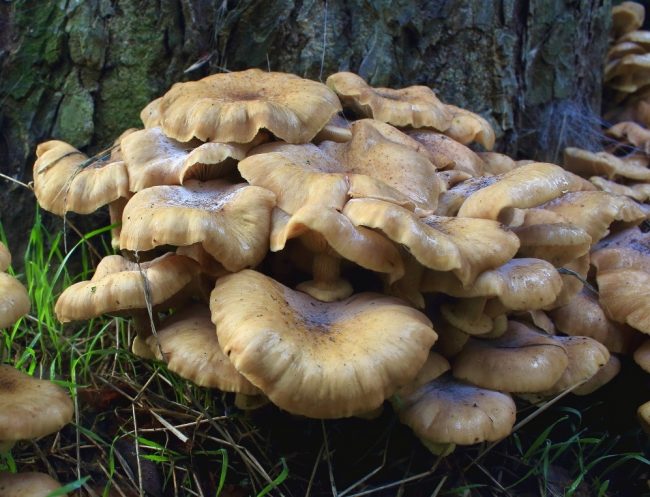
Honey fungus.
Those who claim gathering mushrooms does no harm often point towards the famous example of the massive colony of Honey Fungus that was discovered just over a decade ago and whose mycelium stretched throughout 2,384 acres (965 hectares) of soil in Oregon’s Blue Mountains]. This is clearly an exceptional case however, with others probably nowhere near so expansive. Obviously a tiny mycena growing on a twig does not have such a substantial mycelial network underpinning it. It is equally clear that in the United Kingdom, areas of unsullied ancient woodland of similar sizes as can be found in North America, Eastern Europe, or even much closer to home across the channel, just don’t exist. We might have enough habitat to support a degree of fungal diversity in our few wild spaces left, but not if we have too many otherwise well-meaning nature-lovers descending to strip them bare of ceps and chanterelles and whatever else the guides deem edible. Just as it is now clear that our oceans aren’t bottomless food resources, we should be aware that our woodlands most likely aren’t either.
I’ve seen comments by Michael Jordan, the founder and chairman of the Association of British Fungal Groups (ABFG), that liken fungi foraging to picking wild flowers: for every common poppy or daffodil you pick, you might be destroying a unique wild orchid that only occurs in a certain habitat. There was a time too when we had a seemingly infinite array of butterflies flitting around our once abundant wildflower meadows, or when even collecting birds eggs was at one point considered an acceptable pastime.
Nicholas Money has a whole chapter in his highly-readable Mushroom (2011) entitled ‘Satan’s Gourmand: Harvesting Wild Mushrooms’, which assesses the pros and cons of foraging in some detail. I personally would hate to come across as one of those persona-non-gratis of ‘pick-shamers’ within nature-loving circles: I certainly eat some of what I find, and I also take samples home for research and identification purposes. But I think Money is on the money when he writes of “well-meaning aficionados [who] seem to revel in posing with huge mushrooms for their friends and for the camera, even the inedible ones” and of a mushrooming magazine that “is open next to me, featuring a photograph of a middle-aged woman proffering an enormous bolete that she has loosened from the ground. The cap is as big as her head. She is grinning as if she won the lottery and evincing an almost unsustainable joy. Why did she detach this beautiful fruit body from its colony and its moisture source? Mushrooms are never going to attract the same kind of reverence as polar bears and other charismatic megafauna – I’m resigned to this – but such beautifully constructed things merit more than the ignominy of festering into slime in a trash can.”
So, to eat or not to eat? This is a dilemma I’ll leave the reader to ponder now I’ve presented my thoughts on the subject. However, I use it to introduce a category of fungi that I would advise anyone not to contemplate for the pan. These are the amanitas, characterised by the poster child for the genus, the Fly Agaric, with its vibrant red cap and white spots familiar from fairy-tale illustrations and 1990s video console games.
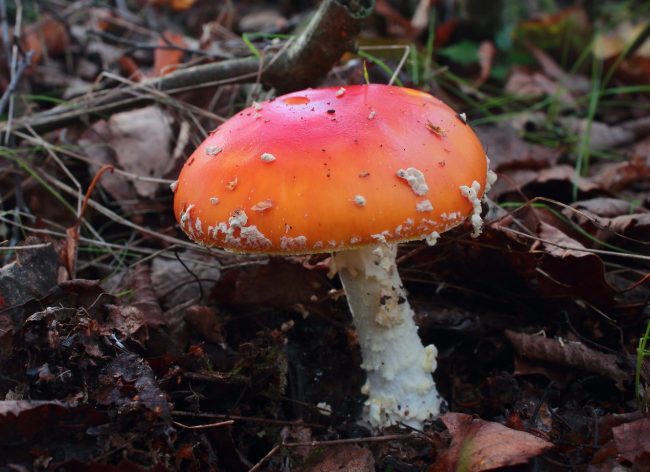
Fly Agaric (Amanita muscaria).
The amanitas include some of the most deadly species out there: the Destroying Angel, the Death Cap and the Panther Cap. Not all signal their toxicity by their cap colour. The Destroying Angel (Amanita virosa) is a fairly nondescript white, for example (incidentally, this common name is used in America to describe a number of species, but in the UK it is only applied to A. virosa). And as with the russulas, and indeed many other types, we shouldn't assume that the bite or nibble marks left by other creatures means they are edible to humans, who possess very different metabolisms from bugs, slugs and squirrels. The amatoxins in Amanita virosa can lay you up in hospital for some time and leave you with permanent liver damage, assuming you survive in the first place.
Fortunately, Destroying Angels don’t appear to be so common across the UK. As Pat O’Reilly describes on the First Nature entry, they are “more plentiful in mountainous areas in Britain and Ireland. It is not uncommon in low lying areas in northern Scotland and is a very common find in Scandinavian conifer forests (of which there are many!)”. I have personally never found one myself, but the immediate impression I always get when looking at photos of them is their elegantly tall and slender form and an almost overpowering pristine porcelain whiteness.
White or just off-white gills and flesh characterise the amanitas. Peel the red skin off the cap of the Fly Agaric for example, and it’s all white beneath. Although not all amanitas are toxic, and although not all fungi with white gills are amanitas, the white gills alone should be enough of a red flag to tell you that a mushroom is potentially lethal. Amanita gills are also either free of the stem or adnexed – that is, they don’t run up to or connect with the stipe. Spore prints show “whitish or somewhat greenish spore-deposits” according to Laessoe and Peterson’s Fungi of Temperate Europe, although my own basic research shows that under the microscope the shapes and sizes for different Amanita species aren’t particularly distinctive.
For other distinguishing hallmarks, let us turn our focus to the Death Cap (Amanita phalloides), with the sickly greenish tinge to its yellowish cap hinting that it is probably something you wouldn’t want to put anywhere near your mouth.
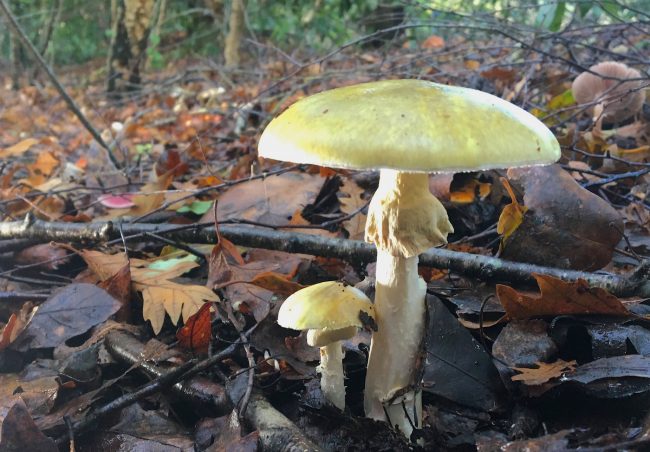
Death Cap (Amanita phalloides).
It is a lot more common in the UK, although apparently this species that, according to this article in The Atlantic, “accounts for more than 90 percent of mushroom-related poisonings and fatalities worldwide”, is only a fairly recent arrival in North America, transported on the roots of imported trees from Europe.
One of the most distinctive features the Death Cap shares with Fly Agarics and Destroying Angels is a very pronounced hanging ring around the stipe, remnants of the so-called ‘partial veil’ (or inner veil) that originally stretched between the cap margins and stalk covering the gills as the fruit body was growing.
The iconic Fly Agaric, whose ring around the stalk just below the cap is evidence of its partial veil and the white dot-like patches on the cap surface remnants of the universal veil.
The stems are also what we might term as floccose, with a slightly flakey appearance, rather than smooth.
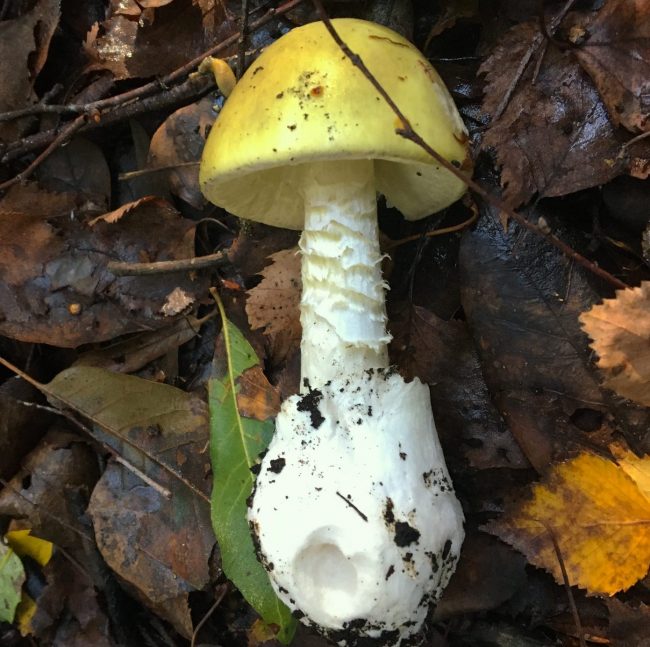
A young Death Cap showing the floccose stem and the volva it has emerged from, although the partial veil is not evident in in this photo.
Not all amanitas have these rings, but they usually bear traces of the universal veil, sometimes called the outer veil or velum, which is the membranous covering the envelops a developing fruit body, making an immature amanita appear like a tiny white egg or sphere, a reason to be very wary when it comes to picking what might otherwise look like small puffballs in woodland environments – they might well be nascent Death Caps or suchlike.
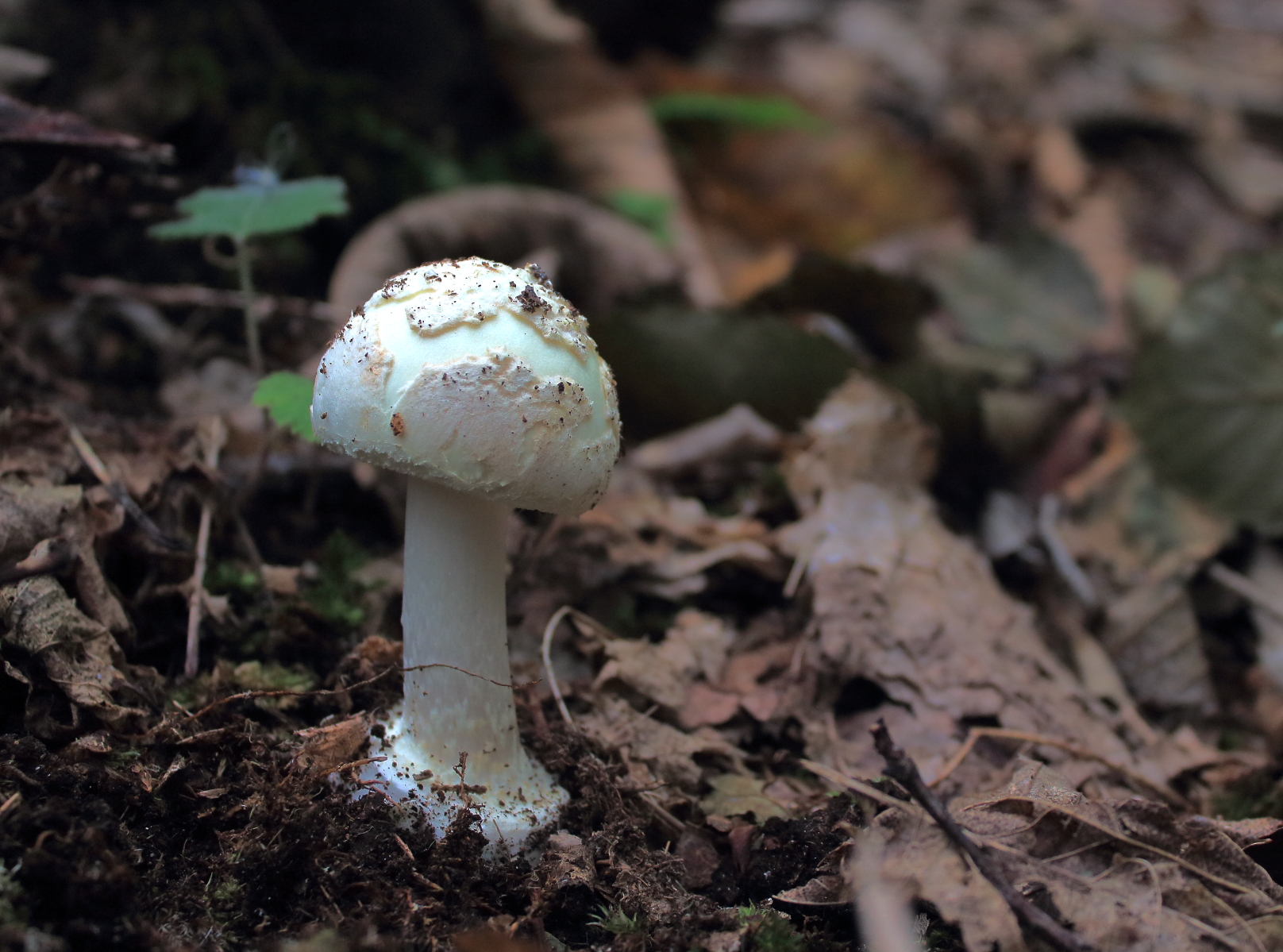
The universal veil still covering much of the cap of this young fruitbody of a False Deathcap.
So this universal veil is white, but when the mature mushroom bursts through it and opens up like an umbrella, traces of it remain in the form of the volva, a large bulbous structure at the basis from which the stem emerges, and in the tatty remnants on whatever colour cap the mushroom has. The white dots on the red cap of a Fly Agaric and other species are, in fact, tiny patches of the velum.
You’ll not see such conspicuous veil remnants on the Death Cap (nor indeed the Destroying Angel, where they would be unnoticeable because they are more or less the same colour anyway). Death Cap typically possess a smooth and spotless olive-green cap. Not so for Amanita citrina, whose common name of the False Death Cap seems slightly inappropriate to my mind, because the veil remnants which radiate out from the centre of the cap make it pretty distinguishable from its deadly namesake, as does the more lemony yellow colour.
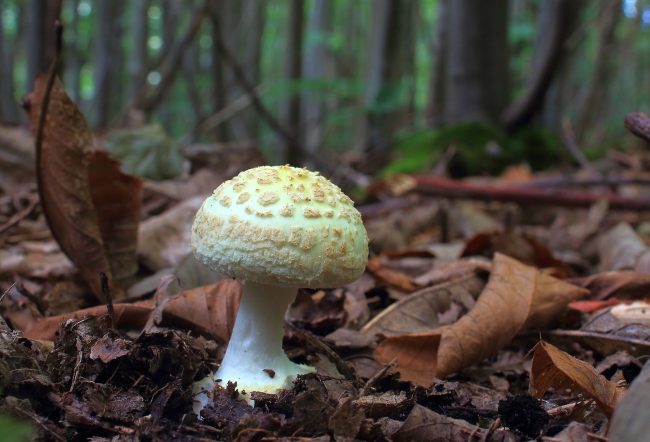
The False Deathcap (Amanita citrina) showing the remnants of the universal veil on the cap that distinguish it from the Death Cap.
Those with keen nostrils might also be able to make out the smell or raw potato that most guidebooks draw attention to as a distinguishing feature of this type. In any measure, this is another to keep well away from if you are looking at potential omelette fillers.
And that just leaves one further species for this month’s post, which is the Solitary Amanita (Amanita solitaria), so called because they tend to like growing singly, although this isn’t always the case.
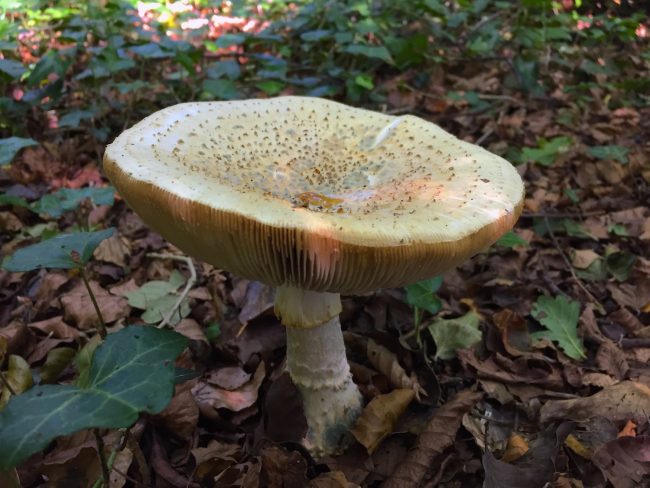
The Solitary Amanita, confident in its own company, whether the velar remnants on the cap surface almost appear to form spines.
They have an alternate Latin binomial name of Amanita echinocephala, the latter part meaning ‘spiny head’, and the veil remnants on their caps are indeed a slightly pyramidal shape and a lot more pronouncedly spiny than the others I have mentioned.

A Solitary Amanita that some woodland critter has been nibbling on, although this doesnt make it fit for human consumption.
Otherwise the cap is a smooth white or cream-ish colour that might overlap with that of the False Death Cap, but the stems are fatter and the fruitbody in general seems a lot chunkier.
The Solitary Amanita, as Pat O’ Reilly describes, is “very rare in Britain and Ireland” and “mainly restricted to alkaline soils typical of the beechwoods of southern England”, just as the Destroying Angel is more common in the higher grounds of Scotland.
Nevertheless, its favouring of chalky, calcareous soils make it locally quite abundant in some regions, which explains why I, living in the Southeast, seem to have come across it relatively frequently in such places as a small copse less than a mile away from the cliff’s edge just outside of Dover, and in a wooded valley in the South Downs near Chichester.
We should also mention that there is another species called the Warted Amanita (Amanita strobiliformis) that is larger and chunkier, but otherwise looks pretty similar. Regardless of the toxicity or edibility of any of these individual species, the point remains that there is so much scope for confusion between the amanitas that you are better off avoiding all of them at all if you want to see out the end of the mushroom season.
Comments are closed for this post.
